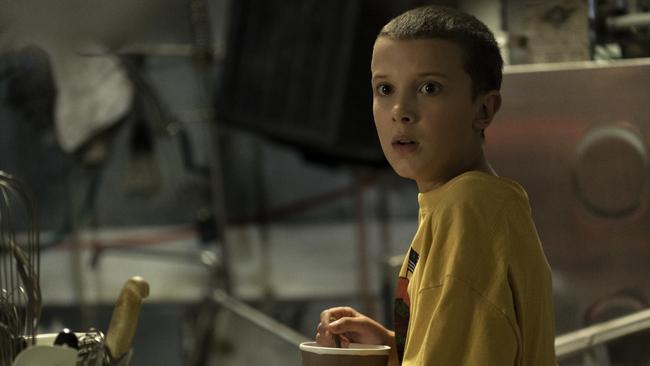Netflix scrambles to attract new subscribers to help pay its $17 billion programming bill
IT MIGHT be pulling in all the Emmys, but the online streaming giant has a huge problem that could put its future at stake.

NETFLIX is pulling in new viewers and award nominations in droves, with shows like House of Cards and Orange Is The New Black continuing to please.
But the online streaming service still faces a long-term problem: Its acclaimed programming line-up is costing far more money than what subscribers pay for it.
The company has signed up for close to $17 billion worth of content over the next three years, an amount that far outweighs its current revenue streams.
Investors in the California-based company are betting on Netflix’s ability to keep ramping up the number of subscribers, in the hopes that its programming investments will pay off.
Netflix delivered a hopeful result on Monday, announcing it had added 5.2 million subscribers in the second quarter covering April to June.
That’s the largest increase ever during the period, which has always been the company’s slowest time of year.
Wall Street rewarded Netflix by driving up its stock by more than 10 per cent to $178.30 in extended trading, putting the shares on track to hit a new high in Tuesday’s regular trading.

BURNING THROUGH $17 BILLION
Netflix is locked into contracts requiring it to pay more than $16.7 billion ($US13 billion) for programming during the next three years, a burden that has forced the company to borrow to pay its bills.
After burning through $US1.7 billion in cash last year, Netflix expects that figure to rise to as much as $US2.5 billion this year.
It’s continuing to invest in more original programming amid increasing competition from the likes of Amazon, Hulu and YouTube.
Netflix expects to be spending more money than it brings in for several more years. It posted a more detailed explanation about its negative cash flow to give investors a better grasp of its programming expenses.
The company is still profitable under corporate accounting rules, although its earnings remain puny by Wall Street standards. It earned $US66 million on revenue of $US2.8 billion in revenue during its latest quarter.
Funding international operations remains Netflix’s biggest financial drag, although the overseas losses are narrowing.
The company now expects its international operation to produce a small operating profit for the full year.
TIME TO DITCH ‘ONE SIZE FITS ALL’ APPROACH
Netflix now has 104 million subscribers worldwide and, for the first time in its history, most of those subscribers (slightly more than 52 million) are outside the United States — including Australia.
Having viewers all over the world means Netflix will need to keep creating more shows that appeal to the unique interests of viewers in countries with diverse tastes, including Japan, India and Indonesia — which could further complicate its cost issues.
“It is going to be imperative for them to have more locally produced-content,” CFRA Research analyst Tuna Amobi said. “They can’t afford to pursue a ‘one-size- fits-all’ strategy.”

As part of its efforts to boost its profits, Netflix is becoming more aggressive about dumping shows that aren’t drawing enough viewers to justify their costs.
In the second quarter, Netflix jettisoned both the high-concept science fiction show Sense 8 and the musical drama The Get Down.
In a letter to shareholders on Monday, Netflix chief executive Reed Hastings made it clear that the company plans to exert more discipline in the future.
“They are becoming more like any other Hollywood studio and paying more attention to the economics of their shows,” Mr Amobi said.
EMMY-WINNING PROGRAMMING COUPS
The subscriber growth further validates Netflix’s decision to expand into original programming five years ago.
Two of its longest running shows — House of Cards and Orange Is The New Black — recently launched their latest seasons.
Those two series, along with newer hits like Master of None and 13 Reasons Why, helped Netflix easily surpass the average 1.8 million subscribers it has added in the second quarter over the past five years.
Later this year, new seasons of two other hits, Stranger Things and The Crown, are due. Those two series accounted for about a third of the 91 Emmy nominations that 27 different Netflix programs received last week — more than any other TV network except its role model, HBO, which landed 111 nominations.
WILL PRICES GO UP AGAIN?
Netflix also could make more money by raising its prices closer to the $US15 per month that HBO charges for its streaming service, but the company has said no increases were planned in the near future. Netflix’s US rates currently range from $US8 to $US12 per month.
In Australia, the Federal Government’s digital downloads tax has pushed up the cost of Netflix and other streaming services.
This bumped the nation down from being the ninth most affordable place in the world to use the streaming service, to the 170th, according to comparison site Finder.com.au.
A basic subscription in Australia has gone up from $8.99 to $9.99 a month, a standard package from $11.99 to $13.99 and premium from $14.99 to $17.99 — allowing users to stream on four devices at the same time in HD and 4K.



